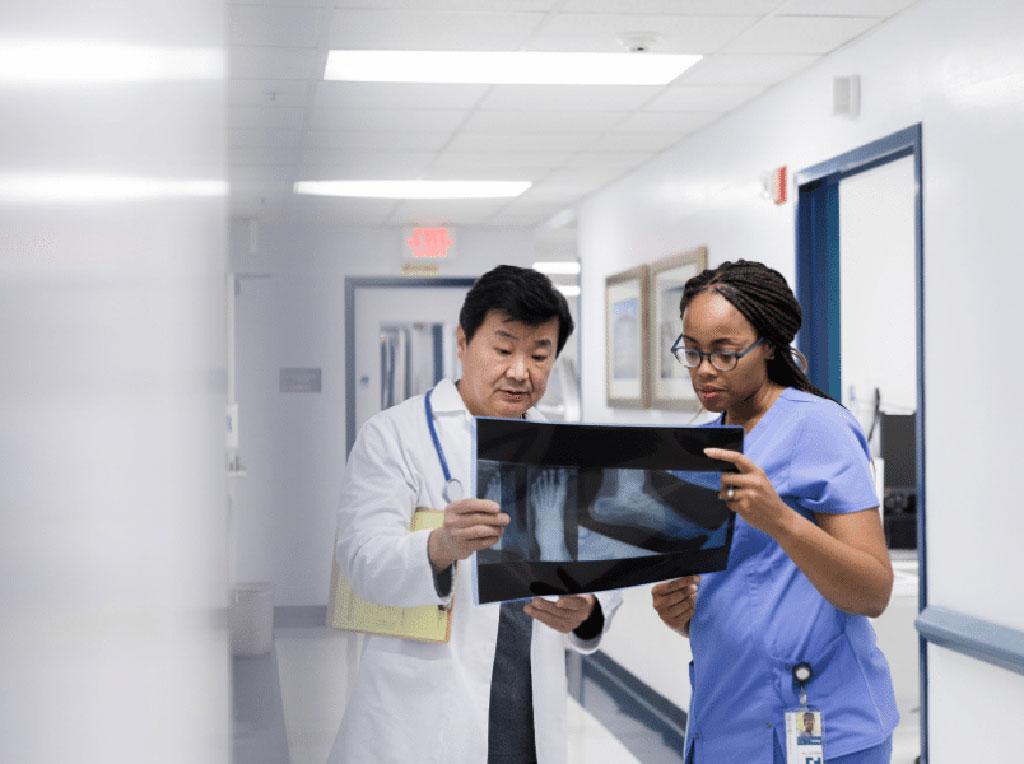Injuries happen, and most injuries affect the musculoskeletal system, which includes the bones, joints, and muscles. In fact, 77% of injury-related healthcare visits are musculoskeletal. If you have a musculoskeletal injury, the pain or lack of mobility can prevent you from going to work or school, taking care of your family, playing your favorite sport, or simply completing everyday tasks. What’s more, your injury – and the pain or disability it causes – can progress over time if not properly treated.
Fortunately, a visit to a trusted orthopaedic doctor or surgeon can prevent your injury from getting worse. Here’s everything you need to know about orthopaedic care to treat injuries.
Types of Musculoskeletal Injuries
Orthopaedist doctors specialize in diagnosing and treating musculoskeletal issues, including orthopaedic injuries. The most common orthopaedic injuries are:
- Fractures – broken bones.
- Sprains – stretching or tearing of ligaments that connect bones and joints.
- Strains – stretching or tearing of tendons that connect muscles to bones.
- Contusions – a bruising of the bone; less severe than a bone fracture, but still painful.
- Dislocations – a separation of the bones where they meet at a joint, which can cause internal damage.
- Crushing injuries and open wounds.
- Amputations.
Risks Associated with an Untreated Orthopaedic Injury
An orthopaedic injury – regardless of severity – can negatively affect your life, especially if it is left untreated. The risks of neglecting treatment vary according to the type of injury. For example, the risks of not treating a fracture can include:
- Pain.
- Refractures.
- Deformity that is unsightly and leads to mobility or function problems.
- Joint damage that changes the way a joint functions, which can lead to degeneration and arthritis.
- Muscle, ligament, or nerve damage, as a broken bone can injure or tear nearby tissue.
- Blood clots or a dangerous condition that’s known as deep vein thrombosis (DVT).
- Tissue or bone death resulting from blocked blood vessels.
Risks of not treating ligament, tendon, or muscle injuries include:
- Pain.
- Increased damage – small tears may become larger, for example.
- Instability that causes clicking, catching, buckling, or other injuries.
- Disability – partial tears can become full ruptures and leave no connection between your bones and muscles. This makes it hard to put weight on your leg, bend or straighten your knee, stand on your tiptoes, or walk with a normal heel-to-toe stride.
- Arthritis.
Prevent Injuries or Keep Your Injury from Progressing with Orthopaedic Care
As its name suggests, orthopaedic preventative care can prevent musculoskeletal injuries. Orthopaedic specialists help patients evade injuries by assessing the patient’s risk of breaking a bone or experiencing a sprain, strain, or other orthopaedic injury based on their lifestyle and activity level. Basketball players and other athletes are at risk of joint dislocation, for example, while football, soccer, and basketball players have a higher risk of experiencing sprains.
An orthopaedic doctor can help athletic patients use proper form to reduce the risk of these injuries. If a patient is already suffering from an injury, orthopaedic surgeons can work alongside other medical professionals (such as physical therapists and pain management specialists) to help prevent further damage. An orthopaedic team is also equipped to help patients improve their function and mobility, reduce pain, and improve their quality of life.
Ignoring an injury can lead to further complications. A broken bone may impair nearby tissue, for example, while a tendon tear may completely separate the muscle from the bone. This may make the original condition much more difficult to treat. Untreated injuries can also result in more extensive treatment and longer recovery time. The cost of an untreated or undertreated injury can also be much higher.
When Surgery is the Next Step, Trust Our Orthopaedic Doctors
Our orthopaedic specialists do everything they can to help patients avoid surgery, but sometimes orthopaedic surgery is the only way to prevent an injury from getting worse. If it’s time to consider surgery, trust the experts at Valley Orthopaedic Specialists.
Why Should You Consider Surgery for an Orthopaedic Injury?
The reasons to have surgery after an orthopaedic injury can vary from person to person. Some reasons to consider surgery to treat an injury can include:
- Reducing pain.
- Improving your range of motion.
- Optimizing performance.
- Improving your ability to perform everyday tasks.
- Preventing the injury from getting worse.
Frequently Asked Questions about Preventing an Injury from Worsening Through Orthopaedic Care
What is an Orthopaedic Clinic?
An orthopaedic clinic is a facility that offers care focused on the health of the musculoskeletal system.
What is an Orthopedics Doctor?
An orthopaedics doctor is a physician who has undergone training in maintaining the musculoskeletal system. They are specialists in diagnosing and treating conditions affecting bones, muscles, joints, tendons, and ligaments
What Does an Orthopaedic Doctor Do?
An orthopaedic doctor works to prevent, diagnose, and treat disorders affecting the bones, joints, ligaments, muscles, and tendons.
Do Orthopaedic Injuries Always Require Surgery?
Not all orthopaedic injuries require surgery. Some types of injuries respond well to oral medications, injections, physical therapy, and other treatments. In some cases, though, orthopaedic surgery helps injuries heal and reduces the risk of complications later.
Who Should I Contact for More Information?
Contact Valley Orthopaedics Specialists to learn more about how orthopaedic care or surgery can help prevent your injury from progressing. Our orthopedic doctors in CT can assess your injury and determine the best treatment plan. The best orthopaedic surgeons in CT are here to help you live pain-free.

